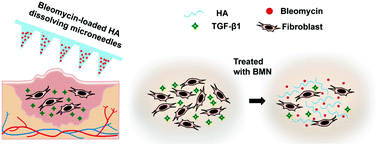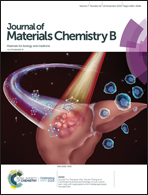Enhanced in vitro efficacy for inhibiting hypertrophic scar by bleomycin-loaded dissolving hyaluronic acid microneedles†
Abstract
Hypertrophic scarring is a widespread skin disorder that affects a patient's confidence and quality of life. Intralesional injection of bleomycin is one of the most commonly employed treatments for hypertrophic scars, which, however, always brings pain and requires long-term treatment. To overcome these limitations, new methods for bleomycin delivery enabling painlessness, self-administration, the fast onset of action, and good bioavailability are urgently needed. In this study, we developed bleomycin-loaded dissolving microneedles (BMN) made up of hyaluronic acid (HA) with excellent aqueous solubility and enhanced efficacy for inhibiting hypertrophic scars. The as-obtained BMN possesses sufficient mechanical strength to pierce porcine skin ex vivo with an insertion depth of over 300 μm. Moreover, BMN can dissolve rapidly and release 20% of loaded bleomycin within 1 min and 52% within 10 min, and the BMN-treated skin could recover to its original status within 3 h, demonstrating good biocompatibility. Besides, the HA matrix also maintains the stability and activity of bleomycin. Furthermore, we show that BMN consisting of HA and bleomycin can inhibit the proliferation of human hypertrophic scar fibroblasts (hHSFs) and the secretion of transforming growth factor-β (TGF-β1) in vitro. Therefore, bleomycin-loaded dissolving HA microneedles provide a potential route to treat hypertrophic scars in a convenient, efficient, and minimally invasive manner.



 Please wait while we load your content...
Please wait while we load your content...